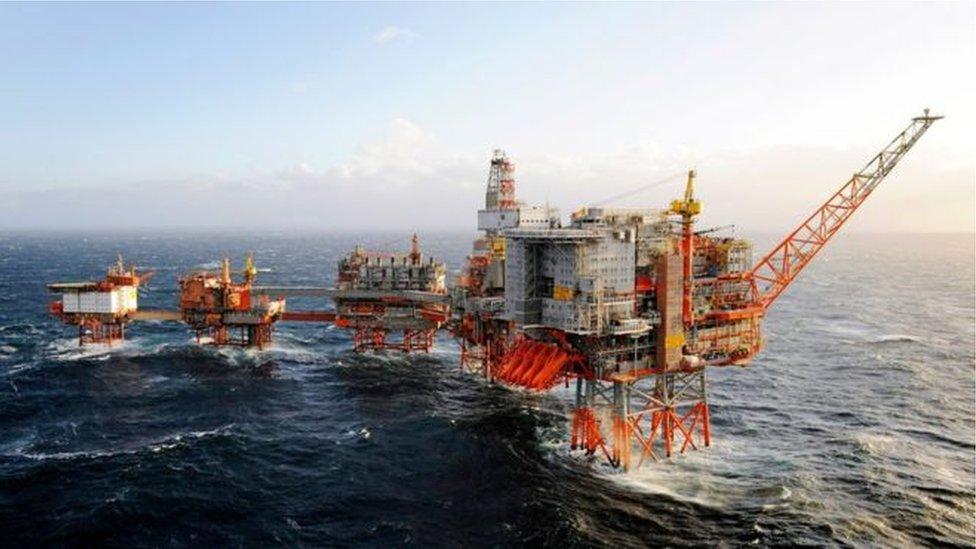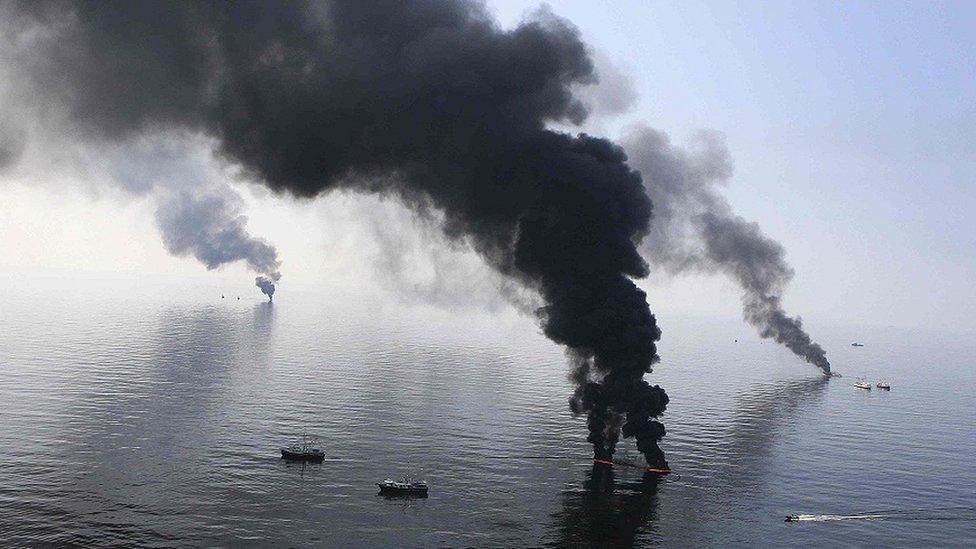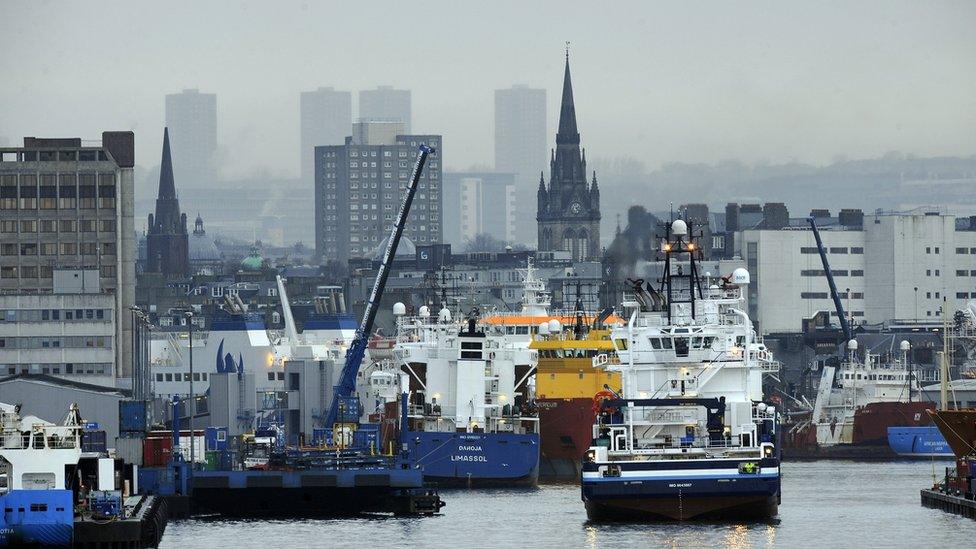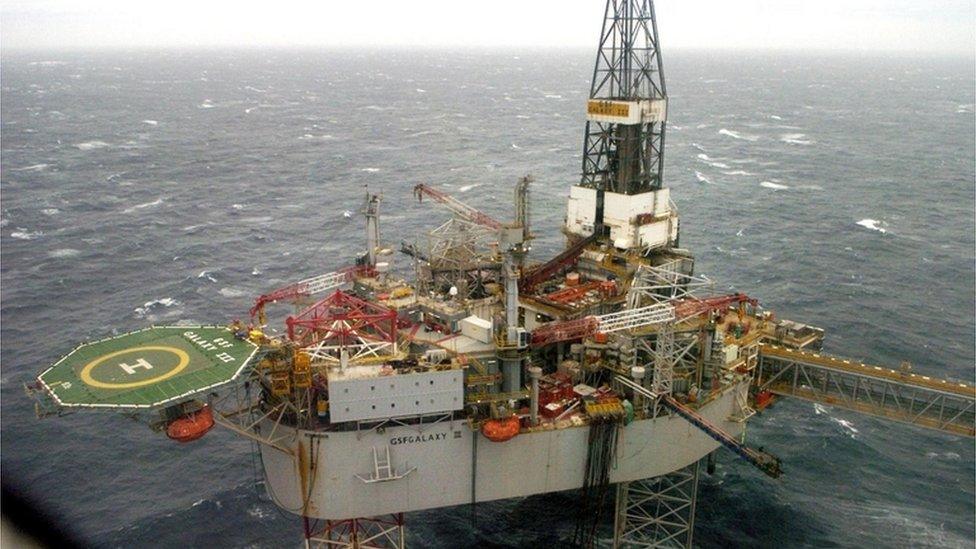Oil industry: lower for longer
- Published

The oil and gas sector in the North Sea has suffered due to the global fall in oil prices
You can see the oil industry's woes for yourself, at anchor in the Firth of Forth. Very Large Crude Carriers are parked off the coast of East Lothian until the price rises, full of North Sea oil recently loaded through the Hound Point terminal.
Onshore storage facilities are full. You can see other tankers at rest and laden with the crude stuff off the coasts of Suffolk and Cornwall.
The gamble made by oil traders is that the cost of storing oil in these tankers - two million barrels in each of the larger ones - is less than the gain to be made out of waiting to sell it.
But industry hopes of a rise in the oil price have been dashed time and time again over the past two years.
Other consequences can be seen over the horizon, on Shell platforms, where Wood Group maintenance workers are back on strike this coming week, in protest at the sharp cut to their pay.
Others have protested at the change to rotas, shifting from two-week turnarounds to three-weeks.
Cost-cutting
The consequences were also clear from another grim week for the oil and gas industry, as the majors unloaded their half year results.
The message was consistent, and no reassurance to those offshore workers facing diminished pay and conditions - the cost-cutting goes on.
As the results were published, the oil price fell yet again. Brent crude fell below $43, down 20% from a peak it reached in early June.
With global supply still buoyant, the short-term expectation is for a continued fall, even if those tankers at anchor in the Forth are a sign of expectations that the price will pick up again before too long.
Dollar bills
In Britain, it is no compensation for the oil industry that the dollar value appear more attractive in pounds, following the weakening of sterling.
The industry thinks, invests, accounts and reports in US dollars. The exchange rate becomes an issue when it reaches the customer.
That rise in the sterling price for a given dollar rate represents the increased cost, for those who earn and invest and buy their fuel in pounds - businesses and households alike.

The pound has dropped against the dollar - the currency the oil industry accounts, invests and reports in
In other words, a drop of more than 10% in the average price of oil over the past two months, allied to a 10% drop in sterling against the dollar, means fuel is cheaper, but not as much cheaper for British consumers as it is for foreigners.
For the industry, the main concern about the impact of Brexit is not about access to markets or regulation of the industry but about the prospect of economic slowdown hitting demand. It may yet do so in Britain, but the concern of it doing so worldwide as a result of the Brexit vote is significantly lower than it was a month ago.
Profits of doom
Back to those corporate first half results, coming two years after the slide began from $115 per barrel. The majors had already taken a huge hit, but now they're reporting on the consequences of the price of oil staying lower for longer.
In the past few days, we've seen BP's profits down by 44% on the second quarter of 2015. That reflects an average oil price of $39 in the second quarter this year, against $55 last year.
After six years, BP announced it is "drawing a line" under the Deepwater Horizon explosion and spill in the Gulf of Mexico, or so it hopes. The bill (so far): $61 billion, or £47 billion.

BP hopes it can put incidents like the Deepwater Horizon spill behind itself
The April to June profit at Royal Dutch Shell was down more than 70%. Including one-off items, it was down 93%.
On its upstream activities - producing oil and gas rather than refining and selling it - the loss was $1.33bn, more than double the level last year.
A month ago, its chief executive said it would "have to take a good look at the more mature assets in the North Sea".
The British-Dutch giant is now the biggest producer in UK waters, since taking over BG.
Centrica reported on progress in reducing upstream production sharply. It helps to achieve its target of retreat from offshore exposure by doing no exploration whatsoever.
In the US, the week ended with Chevron reporting a $1.5 billion loss for the second quarter of the year.
Exxon Mobil cut its exploration and capital expenditure by 38% - more than $5 billion - but with both upstream production and refinery earnings taking a hit, half-year profits were down 64%.
Rig market
That reduction in capital and exploration expenditure has been sharp and huge.
Wood Mackenzie, the Edinburgh-based energy consultancy, said last week that $230 billion has been stripped out of capital spending in the past two years by 56 of the biggest oil producers.

Rig-building is down to 32% of its level in 2014
Rival consultancy Douglas-Westwood has been calculating the impact on spending on global oilfield services - dropping 38% last year, and 15% this year.
It forecasts a recovery at a healthy-sounding 8% increase year-on-year. But by 2020, that is still 71% of the level in 2014.
Oilfield equipment - primarily the building of rigs for onshore and offshore - is down to 32% of its level in 2014, and with few projects being given the green light recently, Douglas-Westwood foresees "a void in construction in the long term".
Dividend plunge
The impact on profits has been profound. The WoodMac study found that dividend distribution has fallen by $59 billion in two years. That staggering figure is an important one for retail investors and pension savers, for whom oil and gas shares play a large role.
That WoodMac survey also noted the success of companies in cutting costs and exiting higher cost fields. Two years ago, the majority of the big 56 were producing oil at a break-even price of around $90.
That is now down to an average $50. With Brent crude around $43 and the US benchmark price dipping close to $40, that's still too high, and a "growing list" are reaching the $40 figure.

There is some good news for the oil industry in Scotland - but big problems remain
A word about how this can be seen from Scotland, where public debate displays some misunderstandings of the industry and its impact on the country.
There is good news for the industry. Oil production volumes from the North Sea and West of Shetland are rising, after declining each year since the turn of the century. The oil price has gone up considerably from a low below $30 in January.
New oil and gas fields are still being developed, with some very large fields due to come on-stream soon. Commitment to those was given when the oil price was more than double recent levels, and it looked stable.
More reserves are being found in UK waters, though in small quantities - far too small to replace depleting reserves.
So not all is gloomy. The oil market will recover, sometime...probably. But there are two big problems that afflict the UK offshore industry and Scotland's finances in particular.
One is that an ageing oil basin gets more costly as fields get to the end of their lives, and new fields are developed in expensive, hard-to-reach sub-sea reservoirs. That means it is less profitable than it was.
Oil companies have to justify staying involved, when capital expenditure is finite, and there are bigger, potentially more profitable fields to develop elsewhere.
Taps on
Depending on factors determined far away, the oil price is expected to rise, though not to previous sustained levels above $100. With these cuts in exploration expenditure with which to replace depleting reserves, a shortage of future supply may even see the price spike next decade.
So will the oil bonanza taps turn on again? Will there be big profits, from which big tax revenues can be derived?
Well, even the rosiest of scenarios for the industry look like returning significantly less tax revenue to either the Treasury in London - or to Holyrood, were it to win control over North Sea taxation.
Tax rates have been cut sharply by the Treasury in response to the downturn, with the encouragement of the SNP government to cut further.
That doesn't make much difference while profits are low. Due to investment allowances, tax revenue has recently turned negative. But when profits rise again, the government gets none of that directly, and with lower tax rates, it will be noticeable that tax revenue won't rise as fast.
In the right market conditions, the industry could go on for decades. But that is not to say that the tax revenues will also do so.
- Published13 June 2016

- Published10 June 2016

- Published25 February 2016
